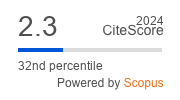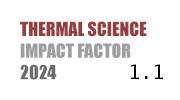THERMAL SCIENCE
International Scientific Journal
Thermal Science - Online First
online first only
Assessment of low-energy potential of a school building using operation optimization and surrogate models
ABSTRACT
The retrofit of existing buildings has a notable potential to save energy and reduce the environmental impact. This paper presents an approach to assess the primary energy saving potential related to the retrofit of a school building. The retrofit includes wall and roof insulation, fenestration replacement, installation of heat pumps with thermal storage, and usage of photovoltaic panels. The approach relies on building simulations and operation optimization to evaluate a limited number of retrofit combinations. The results are used to formulate two kinds of surrogate models based on gradient boosting: (1) classifier that finds feasible options and (2) regressor that estimates the primary energy consumption. The results show high precision of the predictive models. The F1 score of the classifiers exceeds 0.99 even for very small training samples. The most important feature for estimating feasibility is the heat pump capacity. The coefficient of determination of the regressors is close to 1 and the root mean square error is lower than 1 kWh/m2, even for moderate sizes of the training set. The most important feature for predicting energy consumption is related to the area and orientation of photovoltaic panels.
KEYWORDS
PAPER SUBMITTED: 2025-02-27
PAPER REVISED: 2025-04-30
PAPER ACCEPTED: 2025-05-04
PUBLISHED ONLINE: 2025-07-05
- Thrampoulidis, E. et al., Approximating optimal building retrofit solutions for large-scale retrofit analysis, Applied Energy 333 (2023), 120566,
- ****, Energy Sector Development Strategy of the Republic of Serbia up to 2040 with Projections up to 2050, Official Gazette of the Republic of Serbia, No. 94 (2024) (In Serbian)
- Życzyńska, A. et al., Improving the Energy Performance of Public Buildings Equipped with Individual Gas Boilers Due to Thermal Retrofitting, Energies 14 (2021), No. 6, 1565,
- Życzyńska, A. et al., Energy Effects of Retrofitting the Educational Facilities Located in South-Eastern Poland, Energies 13 (2020), No. 10, 2449,
- Ranđelović, D. et al., Investigation of a passive design approach for a building facility: a case study, Energy Sources, Part A: Recovery, Utilization, and Environmental Effects 47 (2021), No. 1., pp. 8890- 8908,
- Papadakis, N. and Katsaprakakis, D. A., A Review of Energy Efficiency Interventions in Public Buildings, Energies 16 (2023), No. 17, 6329,
- Sánchez, E. C. et al., Architectural and environmental strategies towards a cost optimal deep energy retrofit for mediterranean public high schools, Energy Reports 9 (2023), pp. 6434-6448,
- Ciacci, C. et al., Evaluation of the Cost-Optimal Method Applied to Existing Schools Considering PV System Optimization, Energies 15 (2022), No. 2, 611,
- Baglivo, C. et al., Dynamic Evaluation of the Effects of Climate Change on the Energy Renovation of a School in a Mediterranean Climate, Sustainability 13 (2021), No. 11, 6375,
- Campagna, L. M. et al., Life cycle cost optimization for schools energy retrofit under climate change: Methodological approach and analyses in five different climates, Energy and Buildings 335 (2025), 115561,
- Jovanović, M. P. et al., Assessing the sustainability of Serbian school buildings by analyse and synthesis parameters under information deficiency method, Thermal Science 22 (2018), Suppl. 4, pp. S1271- S1283,
- Cruz, A. S. et al., Multi-objective optimization based on surrogate models for sustainable building design: A systematic literature review, Building and Environment 266 (2024), 112147,
- Prina, M. G. et al., Machine learning as a surrogate model for EnergyPLAN: Speeding up energy system optimization at the country level, Energy 307 (2024), 132735,
- Asadi, E. et al., Multi-objective optimization for building retrofit: A model using genetic algorithm and artificial neural network and an application, Energy and Buildings 81 (2014), pp. 444-456,
- Sharif, S. A., and Hammad, A., Developing surrogate ANN for selecting near-optimal building energy renovation methods considering energy consumption, LCC and LCA, Journal of Building Engineering 25 (2019), 100790,
- Alexakis, K. et al., Genetic algorithm-based multi-objective optimisation for energy-efficient building retrofitting: A systematic review, Energy & Buildings 328 (2025), 115216,
- ****, EnergyPlus, Energy Simulation Software,
- Edwards, R. E. et al., Constructing large scale surrogate models from big data and artificial intelligence, Applied Energy 202 (2017), pp. 685-699,
- Lawrence, C. R. et al., Application of surrogate modelling to improve the thermal performance of single-family homes through archetype development, Energy & Buildings 237 (2021), 110812,
- Bamdad, K. et al., Building energy optimization using surrogate model and active sampling, Journal of Building Performance Simulation 13 (2020), No. 6, pp. 760-776,
- Herbinger, F. et al., Building energy model calibration using a surrogate neural network, Energy & Buildings 289 (2023), 113057,
- Manmatharasan, P. et al., AI-driven design optimization for sustainable buildings: A systematic review, Energy & Buildings 332 (2025), 115440,
- Stojiljković et al., Classification of retrofit measures for residential buildings according to the global cost, Thermal Science 25 (2021), No. 4A, pp. 2677-2689,
- Stojiljković et al., Predicting primary energy savings of building retrofit measures with decision-treebased ensemble methods, Facta Universitatis, Series: Working and Living Environmental Protection 17 (2020), No. 3, pp. 151-162,
- Shen, Y. and Pan, Y., BIM-supported automatic energy performance analysis for green building design using explainable machine learning and multi-objective optimization, Applied Energy 333 (2023), 120575,
- Zhu, Y. et al., Application of hybrid machine learning algorithm in multi-objective optimization of green building energy efficiency, Energy 316 (2025), 133581,
- Shi, Y. and Chen, P, Energy retrofitting of hospital buildings considering climate change: An approach integrating automated machine learning with NSGA-III for multi-objective optimization, Energy & Buildings 319, (2024) 114571,
- Alaa, H. et al., Metaheuristic optimization of roof designs to enhance energy performance and thermal comfort using parametrization and machine learning, Solar Energy 286 (2025), 113186,
- Nguyen, A. T. et al., Meta learning regression framework for energy consumption prediction in retrofitted buildings: A case study of South Korea, Journal of Building Engineering 96 (2024), 110403,
- Li, K. et al., Improving building retrofit Decision-Making by integrating passive and BIPV techniques with ensemble model, Energy & Buildings 323 (2024), 114727,
- Imalka, S. T. et al., Machine learning driven building integrated photovoltaic (BIPV) envelope design optimization, Energy & Buildings 324 (2024), 114882,
- Sretenović, A. A. et al., Support vector machine for the prediction of heating energy use, Thermal Science 22 (2018), Suppl. 4, pp. S1171-S1181,
- Sretenović, A. A. et al., Hybrid artificial intelligence model for prediction of heating energy use, Thermal Science 26 (2022), No. 1B, pp. 705-716,
- Jurišević, N. M. et al., Assessment of predictive models for the estimation of heat consumption in kindergartens, Thermal Science 26 (2022), No. 1B, pp. 503-516,
- Milićević, M. M. and Marinović, B. R., Machine learning methods in forecasting Solar photovoltaic energy production, Thermal Science 28 (2024), No. 1B, pp. 479-488,
- IEA, The Future of Heat Pumps, International Energy Agency, Paris, France, 2022,
- Adebayo, P. et al., Development, modeling, and optimization of ground source heat pump systems for cold climates: A comprehensive review, Energy and Buildings 320 (2024) 114646,
- Topić Božič, J. et al., Life cycle assessment of energy green transition goals in Slovenia and Serbia. Heat Pump Example, Thermal Science 28 (2024), No. 6A, pp. 4709-4721,
- Jokić, A. I. et al., Feasibility of closed loop ground source heat pump for residential heating and cooling applications in Serbia, Thermal Science 24 (2020), No. 2A, pp. 965-976,
- Vučković, G. D. et al., Air-source heat pump performance comparison in different real operational conditions based on advanced exergy and exergoeconomic approach, Thermal Science 25 (2021), No. 3A, pp. 1849-1866,
- Aryanfar, Y. et al., A competitive study of a geothermal heat pump equipped with an intermediate economizer for R134a and R513a working fluids, Thermal Science 27 (2023), No. 6B, pp. 5025-5038,
- Kossi, P., Rama, M., Improving the accuracy of heat pump feasibility assessment, Thermal Science 28 (2024), No. 5B, pp. 4381-4394,
- Li, B. et al., Economy and energy flexibility optimization of the photovoltaic heat pump, system with thermal energy storage, Journal of Energy Storage 100 (2024) 113526,
- Krützfeldt H. et al., MILP design optimization of heat pump systems in German residential buildings, Energy and Buildings 249 (2021) 111204,
- Aguilera, J. J. et al., Operation optimization in large-scale heat pump systems: A scheduling framework integrating digital twin modelling, demand forecasting, and MILP, Applied Energy 376 (2024) 124259,
- Stojiljković, M. M. et al., Cost-optimal operation of hybrid heat pump systems with progressive electricity tariffs, Thermal Science OnLine-First (2025),
- Kang, H. et al., Multi-objective sizing and real-time scheduling of battery energy storage in energysharing community based on reinforcement learning, Renewable and Sustainable Energy Reviews, 185 (2023), 113655,
- Kang, H. et al., Reinforcement learning-based optimal scheduling model of battery energy storage system at the building level, Renewable and Sustainable Energy Reviews, 190 (2024), Part A, 114054,
- Dou, Z. et al., Innovative energy solutions: Evaluating reinforcement learning algorithms for battery storage optimization in residential settings, Process Safety and Environmental Protection, 191 (2024), Part B, pp. 2203-2221,
- Chaoran, W. et al., Operational strategy optimization of an existing ground source heat pump (GSHP) system using an XGBoost surrogate model, Energy & Buildings 318 (2024), 114444,
- Ali, U. et al., Urban building energy performance prediction and retrofit analysis using data-driven machine learning approach, Energy and Buildings 303 (2024), 113768,
- Gnekpe, C. et al., Energy Performance of Building Refurbishments: Predictive and Prescriptive AIbased Machine Learning Approaches, Journal of Business Research 183 (2024), 114821,
- Asamoah, P. B. et al., Evaluating the performance of machine learning models for energy load prediction in residential HVAC systems, Energy and Buildings 334 (2025), 115517,
- Stojiljković, M. M. et al., Greenhouse gases emission assessment in residential sector through buildings simulations and operation optimization, Energy 92 (2015), Part 3, pp. 420-434,
- Stojiljković, M. M., Bi-level multi-objective fuzzy design optimization of energy supply systems aided by problem-specific heuristics, Energy 137 (2017), pp. 1231-1251,
- ****, Rulebook on Energy Efficiency of Buildings, Official Gazette of the Republic of Serbia, No. 61 (2011) (In Serbian)
- ****, EnergyPlus Version 23.2.0 Documentation, Engineering Reference, 2023
- ****, Gurobi Optimizer Reference Manual, Gurobi Optimization, LLC, 2024,
- Pedregosa, F. et al., Scikit-learn: Machine Learning in Python, Journal of Machine Learning Research 12 (2011), No. 85, pp. 2825-2830
- Ascione, F. et al., Knowledge and energy retrofitting of neighborhoods and districts. A comprehensive approach coupling geographical information systems, building simulations and optimization engines, Energy Conversion and Management 230 (2021), 113786

